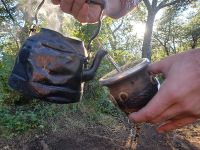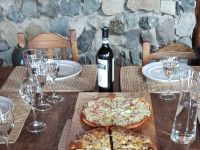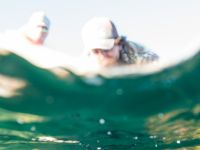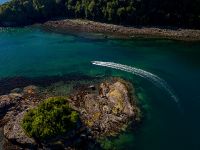Five years have passed since my last trip through the Yelcho Lake area. From that moment, the tales of fishing for Tuna and Sierra fish in the sea always resounded in my mind, and it is just 45 km away from the Yelcho Lodge near the town of Chaitén, in Corcovado Bay.
Fly fishing in remote places that have not been fished much, in my view, has a special flavor.
A new invitation from Sebastián Blanco, the manager, put up the idea of doing a different program: to combine fly fishing in fresh and salt water in the same destination. The possibility of fishing for trout, salmon, tunas and sierras, in one place; something that not many fishing destinations can offer.
This new adventure had Toyota Argentina joining us with a Hilux SRX 4x4 and Eugenio Polanski, a great friend, co-pilot of good talks and eternal drinking of "mate". 4900 km were waiting ahead with unique places and pure adventure around Patagonia (details of the route at the end of the article).
On the way to Yelcho, we went through the incredible Route of the Altars in the province of Chubut, whose stone walls sometimes reach 70 meters high and are a permanent spectacle for dozens of kilometers. It runs from the Atlantic Ocean to the Cordillera mountains and is a good entrance to Patagonia, if one wants to go fishing in this area.
Before crossing to Chile, we camped at Nikita camp on the southern shore of Lake Vintter. At night, with temperatures below zero, Esteban Nikita, its owner, received us with good stories and with his homemade vodka, a recipe that comes from his great grandfather from St. Petersburg to Patagonia.
After two days of travelling and making the first 2000 kilometers, we were finally in Yelcho! We met there with Isaías Miciu, an exceptional photographer and a great friend with whom we have shared a few fishing trips. Joining him were Tomás Sordelli and Kiki de la Canal, two "fishing birds" with several years of experience as guides in North Patagonia, who do not spare a centimeter of water without fishing.
Lastly, as a fundamental part of the group; our guides who would join us during four unforgettable days of fishing; Adrián Suazo and Roland Roberts, two very experienced guides from the area, and permanent staff of the Yelcho Lodge.
Yelcho Lake is located in the Province of Palena, in the X Region of the Lakes, Chile. Of glacial origin, it has an area of 116 square kilometers, and receives water mainly from the Futaleufú River, and then drains through the Yelcho River to the Pacific Ocean.
Being only a few meters above sea level, the mountains that surround it, some crowned by glaciers and eternal snow, look incredibly grand.
It is the end of March, however we are surprised by a quiet morning, with the lake flat and calm, haze and good temperatures. The amount of strikes speaks of the good trout population and little fishing pressure of the lake.
By noon, having fished very well, we cut the day with a good barbecue on a beach of really impressive beauty that I do not remember seeing in other lakes of Patagonia.
We finish the day fishing Bahía Leones, a well repaired place, surrounded by semi-submerged trees, at the foot of the Yelcho Glacier, from where an imposing glacier emerges and sometimes thunders with its ice landslides. This bay, in addition to a dazzling landscape, has an extensive area full of algae with small clearings where the trout patrol and appear from nowhere in front of us generating great fishing situations permanently. Sliding a fat albert over the surface and seeing brown and rainbow trout appear between the thick columns of weeds is very entertaining. A particular spot that is not seen in many other lakes of Patagonia. (These flies cannot be missing, ever, in the fly box: dragonflies, fat alberts, matukas, buggers, and other bigger streamers).
The next day, against all odds, dawned with rain and wind. We decided to postpone fishing in the sea and look for chinook salmon in the Yelcho River. It has a flow of about 350 cubic meters per second, which makes it navigable but you have to know it very well since an error can cost very expensive there.
The landscapes and the coasts of the river covered with thick vegetation such as Coihues, Arrayanes, Ulmos and Nalcas, (typical of an area with a lot of humidity coming from the Ocean), are an experience in itself. A river that dazzles at every moment.
Regrettably, the run of salmon this year has not been very important, so after fishing during an unsuccessful morning, we decided to continue with trout, launching a detailed review of the coasts.
On our third day of fishing, we left to the sea. On the way, we passed through the small town "El Amarillo", the center of the Pumalín National Park created by the visionary Douglas Tompkins, which with more than 400,000 hectares stretches from the heart of the Andes to the fjords of the Pacific coast. It is one of the largest conservation projects in South America designed to protect the Valdivian forests and their fauna.
To go boating from the Yelcho River to the Pacific Ocean, with the Andes mountain range behind us leaning between thick clouds, in search of Tunas and Sierra fish, I am sure it is and will be one of the best fishing adventures of my life. Patagonian landscape with the smell of the sea is something strange, it gives you the framework to a place that never ceases to amaze you at every moment of navigation, between landscape and marine fauna.
With two boats we went south, following the coastline. On the way, a colony of curious sea lions watches us pass, while in the distance we see signs of the first birds, before the presence of a first bank of sardines. Seagulls, penguins, pelicans, cormorants, compete for sardines near the surface, they frantically try to escape. At full speed with the boat and with the gear ready to be used, we go to the place. Nervous waters are seen, desperate sardines are attacked from the water and from the air. In the midst of the commotion, a sierra fish jumps clean out of the water a few meters from our boat to greet us. Adrenaline takes over! Suddenly, no more than 15 meters from us, we see a group of tuna that makes a zigzag attack at full speed. We throw our imitations of sardines, and one tuna gets mine, I hook it and as soon as it starts to run, it lets go without explanation ... @ $% $ # ^ # !!!! After a few seconds they disappear and the place returns to calmness, as if nothing had happened.
It's time to take a break, Roland and Adrián, our guides prepare a barbecue in a quiet bay on the coast of the sea, an unforgettable moment.
Later we continue searching for other feeding birds. The situation happens again several times, but only with attacks from the air, again and again, until suddenly out of nowhere they appear again, the tunas on stage; "there they are" screams Tomy unrestrained, and we fly away!
With the the boat decelerating, his fly falls into the water, a couple of strips and boom! His 10wt rod arches like I've never seen. His Tibor reel, well adjusted, does not stop spinning -at full speed- while the Tuna gets lost in the depths. A Tuna of that size is a serious opponent, pure muscle with marine training, a running machine not suitable for cardiacs. Finally he manages to master it and it is out of the water. Some pictures and it goes back to the water. The joy is shared by the whole group.
The fourth day of fishing we returned to the sea in search of more action. We navigate through a thick mist that does not allow us to see more than 40 meters, with a calm sea. The tide starts to rise and everything seems to indicate that it will be a great day of fishing. However, after following dozens of birds and going after them, we cannot see any Tuna. It is not an easy style of fishing, you have to be very careful, in constant movement, spend fuel and when you finally see a shoal you have to arrive with all the gear ready to launch; just a little extra line out and it will get tangled while you go with the boat; if there is too much line inside the reel, it will not be enough to reach them in the few seconds they give you, when they are within casting range.
They are very powerful fish, to fish for them you have to use #10 fast-action rods that allow to place the fly in the right place in the shortest time possible, leaders of about three meters armed with fluorocarbon of 20 pounds, and a similar steel wire as tippet in case of connecting with a sierra fish. Finally, the flies imitating sardines are about 10cm long with black or blue backs and white belly, with strong hooks. (General recommendation: always go out to sea with two boats, radios and guides who know the area).
We started our way back along the Carretera Austral Norte road, heading to Puerto Varas. A really spectacular road with unique landscapes. Many kilometers of gravel and asphalt that I recommend doing with a 4x4. Between Chaitén and Puerto Varas, the road is finished and you have to take three ferries that go between the Chilean Fjords and they are a very nice experience.
In Puerto Varas, we sleep in the Awa, a design hotel that offers diverse possibilities of nearby fishing. The next morning, Matías Bize, a guide from the area, took me fishing on the Petrohué River for a couple of hours. It is just 30 minutes away from the hotel and it is a good fishing alternative for salmon and trout.
An unforgettable trip that I would repeat without a doubt! Chile has so much to be discovered and the Ruta de las Aguas (Route of the Waters) is a good example of this.
Contact: Yelcho Lodge: https://www.flydreamers.com/en/travel/fly-fishing-lodge-in-chaiten/yelcho-en-la-patagonia-fly-fishing-hotel-in-chaiten-region-de-los-lagos-chile-l-48
Thanks Toyota & Smith Optics!
--------
Route: Buenos Aires, Argentina / Las Grutas / Vintter Lake / Yelcho Lodge / Puerto Varas / Villa la Angostura / Santa Rosa / Buenos Aires.












































































